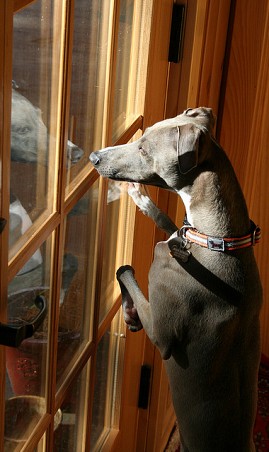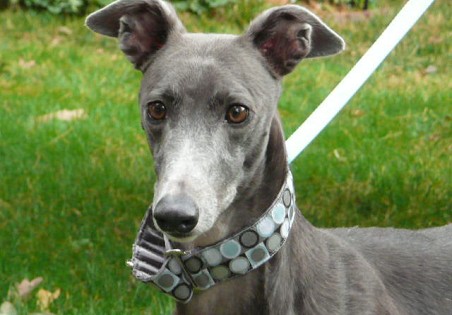Helping a Rescued Greyhound Adjust to Life at Home
 Greyhound racing is a controversial sport, and there are many people who choose to adopt the dogs who can no longer race. Marilyn Wolkovits, owner of Greyhound Adoption Services Inc. in Salisbury, MA, has been teaching how to help the dogs adjust to being a house pet since 1986.
Greyhound racing is a controversial sport, and there are many people who choose to adopt the dogs who can no longer race. Marilyn Wolkovits, owner of Greyhound Adoption Services Inc. in Salisbury, MA, has been teaching how to help the dogs adjust to being a house pet since 1986.
Wolkovits points out that the new owner of an adopted greyhound needs to first realize the dog has never seen a house before. “A major thing, and a lot of people have a hard time with this, is to keep the greyhound crated or in a cage initially. It’s for their protection. Litters of other kinds of dogs grow up in a household and have time to understand what’s around them,” she added.
According to Wolkovits, it generally takes about five months for a retired greyhound to become integrated in a home. “That’s when you really start to see their real personality and behaviors.”
Housebreaking a retired greyhound
The new owner of an adopted greyhound also needs to understand that the dog is kennel-broken, but not house-broken. “Most dogs will not soil where they sleep. Keep them in their crates and when they get restless, take them outside for a few minutes to help them start adjusting,” recommends Wolkovits. She adds that it can be helpful to install a fenced turn-out area in your yard. Due to changes in diet and feeding schedule, the greyhound may experience loose stools for a while.
Safety measures in your home for your adopted greyhound
Wolkovits says that a good age to get a rescue greyhound is around three years old. “They are starting to mature, but they still are playful.” Younger dogs may be more of a handful and get themselves into more “trouble.”
Again, crating is very important to protect your dog, yourself, and your furniture. Wolkovits warns that if you let the greyhound roam freely in the house, when you go out, it may become frantic looking for you and possibly destroy drapes and blinds. “That’s what I’ve heard about the most.”
Baby gates are useful in keeping the greyhound from certain rooms.
If you have sliding glass doors, stick on decals or have some type of window treatment, because greyhounds have a high prey drive. “If they see a squirrel out the door, they will instantly go after it,” cautions Wolkovits.
Screen doors can also be damaged by the dog scratching to get out if it sees another animal it perceives as prey.
 Also, be aware that everything in your home is new to your rescue greyhound and may inspire fear -- and aggression as a result -- so go slow.
Also, be aware that everything in your home is new to your rescue greyhound and may inspire fear -- and aggression as a result -- so go slow.
Other tips to helping your adopted greyhound adjust to being in a home
While you want to have all the usual dog amenities, Wolkovits suggest not going overboard with big fluffy beds or excessive toys. However, the classic Kong (hollow tube filled with kibble and plugged with peanut butter) is entertaining and calming to the dog whether in or out of the crate. Chew toys in general are good to prevent the dog from gnawing on your furniture.
Wolkovits advises, “It’s also better off to start off not allowing the greyhound on furniture or beds. You can decide later if you want to allow that once the dog adjusts to being in a home.”
Even something as normal as stairs can present a challenge to your rescue greyhound. “They may need time to learn how to use stairs. Some are quick learners; others need more time.”
Last, make sure you take time to research and prepare yourself for a rescue greyhound. It may have been abused and may have behavior problems, but not necessarily. Wolkovits recommends avoiding showing off your new companion for a while and being careful where children are involved. “It’s in their nature to be more sensitive than other dogs such as working breeds.”

Greyhound Adoption Services recently renovated their facility with the help of Boston-area concrete contactor Torromeo Industries. Even if you are unable to adopt a greyhound, you can still help them to rescue and find homes for these lovely dogs.
Cris Carl writes for Networx.com.
Updated May 16, 2018.
Looking for a Pro? Call us (866) 441-6648

Remodeling Average Costs
Remodeling Contractors Experiences

Careful, Professional Tree Service Removes A Huge Norway Maple

Ceiling Collapse Caused By A Terrifyingly Negligent Contractor




